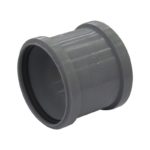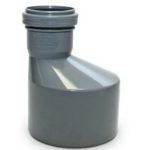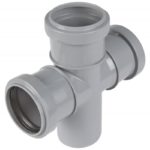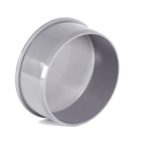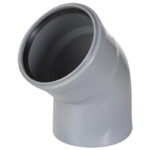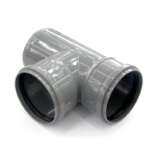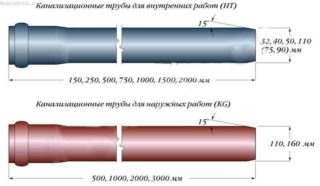Pipes of various diameters are one of the main elements of the sewer system. It is necessary to devote time to their study and selection. The term and efficiency of the system operation will depend on this. Pipes and fittings are made from materials that differ in technical characteristics.
Scope of application of sewer pipes
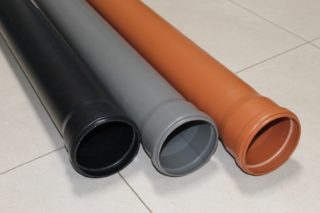
Various types of sewer pipes are used in internal and external systems. They are distinguished by color. The external sewer piping is made of material painted orange so that they can be seen during excavation during renovations. They are stronger and more durable than internal gray ones, as they are operated in extreme environmental conditions, exposed to temperature changes and mechanical stress of the soil.
Inner tubes are gray or white. It is not recommended to use them for external drainage of drains, because they have less load capacity and there is a risk of premature failure.
Black pipes are the middle link in terms of technical characteristics between internal and external communications. Have temperature restrictions - you cannot transfer hot liquid.
Green sewer pipes are for the drainage system. Sometimes sold with a geotextile filter. Drainage communications are pipes with holes. Through them, the liquid enters the filtration fields and goes into the ground.
Pipes for arranging internal and external sewerage, stormwater and drainage systems can be combined and have a common well.
Types and arrangement of pipes for sewage
In addition to straight parts, the system uses elements for connections - fittings. They are intended for transition from a narrow section of a pipe to a wide one, turning, branching, connecting parts:
- coupling - has an O-ring and is designed to connect straight sections;
- branch - used in places where a certain angle must be observed when branching;
- cross - allows you to connect several pipes of a smaller diameter at once;
- reduction - connects samples of different diameters;
- tee - combines several pipes of a small diameter into one wide one - usually at the junction of the internal and external sewers or at the exit from a certain node - a kitchen, a bathroom;
- plug - inspection unit.
In addition to these devices, two-knee siphons and check valves are used. All components have different wall thicknesses and diameters.
The types are distinguished:
- steel;
- cast iron;
- ceramic;
- plastic - PVC, polypropylene, fiberglass, polyethylene, HDPE;
- concrete.
Each type has its positive aspects, if you correctly install and operate the product.
Manufacturing material
There are materials that are practically not used in everyday life, for example, black steel. The material is durable, but problematic from the point of view of installation. To equip the sewage system at the summer cottage, it will be necessary to attract construction equipment and welding specialists, since there are no other methods of joining for metal.
The advantage of black steel is that it can withstand high temperatures and is resistant to aggressive substances. But such properties will not be useful in a home sewer system, so there is no point in overpaying for them.
Ceramic pipes
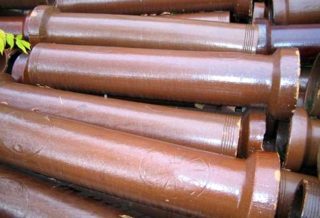
Ceramic is a very durable material that is used in harsh environments. If the groundwater level is close to the surface, then ceramic pipes are not threatened with corrosion, unlike metal ones. The material is resistant to chemicals. The diameter of the ceramic sewer pipe allows them to be used in areas with intensive drainage. The wall thickness makes it possible to lay the pipeline in areas of highways with heavy traffic.
Disadvantages of ceramic communications and installation:
- the material is fragile, therefore it is problematic to cut it, it can be damaged during loading;
- parts are made of short length, so the installation is more time-consuming and labor-intensive;
- does not tolerate low temperatures, so they need to be laid deeper or wrapped with insulation.
Thus, ceramics is not a practical material, although it has some advantages.
Plastic materials

Among modern polymers, especially popular varieties can be distinguished:
- PVC - polyvinyl chloride. Often used in indoor and outdoor domestic sewage systems. The inner walls are smooth and the liquid easily flows by gravity into the sump. Of the minuses - susceptibility to temperature extremes. It is allowed to use water, the temperature of which is not higher than 60 degrees, a short-term increase up to 100 degrees is possible. Distinguish between light, medium and heavy PVC products, which are used depending on the load on the area where the communications are laid.
- Polyethylene. The temperature range is small: from -40 to +40 degrees, which excludes the use of polyethylene communications where the operating temperature of the effluent is higher. Most often, such pipes are laid in the ground or used for cold water supply. HDPE - low-pressure polyethylene - is a more versatile material that is resistant to short-term increases in pressure, withstands high temperatures, and does not deform at the same time. Of the minuses, it is suitable only for underground installation, since it loses its properties under the influence of ultraviolet radiation. Of all types of polyethylene, only cross-linked polyethylene can withstand high temperatures.
- Polypropylene. Has a declared service life of up to 100 years. Withstands aggressive environment and high temperatures, does not break during deformation. Of the minuses - increased sensitivity to ultraviolet light and softness, which requires additional strengthening before laying in the ground.
One of the types of sewer pipes is corrugated. The inner surface is smooth, and the top has a corrugated polyethylene lining. It is used in outdoor systems where increased strength is required. Corrugated pipes can be laid to a depth of 15 meters. The industry produces a variety of product sizes and material combinations to improve performance.
Concrete
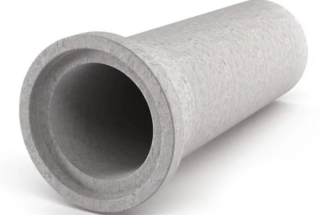
Concrete communications have a high environmental friendliness, but they are very difficult to install - you cannot do without special equipment. A significant disadvantage is the rough inner surface. In a home system, this will lead to rapid adhesion of waste to the walls and the occurrence of blockages. Concrete or asbestos-cement pipes must be handled with care when loading and unloading as they can be damaged. Reinforced concrete is stronger in this respect.
Cast iron
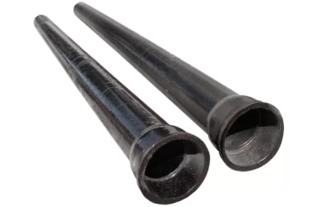
If you choose between steel and cast iron pipes, then the advantage will be on the side of cast iron, because it does not corrode. The prices for it are higher, especially for the modified one, which is more plastic and durable - there is a low probability of cracking and their propagation.
In domestic sewers, where a lot of greasy waste is produced, the rough inner walls of cast iron contribute to the adhesion of dirt, so they will have to be cleaned more often.
The problem is created by the weight of cast-iron structures, therefore, communications are mounted only with auxiliary equipment.
Pipe dimensions
For internal wiring, the diameter is selected from 50 to 100 mm, depending on the type of plumbing. For sinks, showers and bathtubs, 50 mm is sufficient. The toilet is connected with a pipe of 100 - 110 mm. The same section for the common riser. In a private house, pipes with a diameter of 150 mm are installed in the basement through a transition fitting. At the exit from the house, the diameter should be at least 150 mm in order to exclude the risk of blockage at the junction of the internal and external sewerage system.
Main selection criteria
For gravity systems, the wall thickness of the internal wiring must be at least 1.8 mm. When the depth of the external line is up to two meters in the ground, the walls of the products should be thicker - 3.9 mm. When laying up to 4 m - 4.9 mm, up to 6 m - 5.9 mm. The deeper the line lies, the greater the surface load.
Take into account the pressure in the pipeline In gravity systems, it is less than when the pump is running, which pumps the liquid. The pump is connected in the event that it is not possible to comply with the required slope of the sewage system.
Most often, PVC or polypropylene material is chosen for arranging a local sewage system. Fiberglass is popular, but a sewer pipe made of this material is more expensive, because its service life is about 100 years.
To reduce the frequency of cleaning your home system, it is best to select materials with a smooth inner surface that does not adhere to grease and other debris.
Sewer pipe cost
You can overpay for sewer pipes if they are bought to supply drinking water to the house. For example, PVC and polyethylene are not suitable for this purpose, as they emit harmful substances, although it is a reasonable solution to drain wastewater.
The cost of steel pipes does not justify itself. They are not suitable for drinking water, and they will soon rust in the sewage system. Cast iron sewerage is expensive and heavy, but reliable, especially if a magnesium alloy is used.
In terms of price and quality ratio, the best are polypropylene and fiberglass structures. They are the most durable and at the same time environmentally friendly. They are used both in the drinking water supply system and for the construction of sewerage systems.

